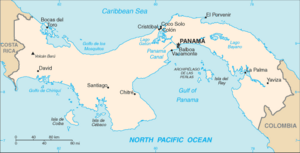Land bridge facts for kids

A land bridge is a term in biogeography. It is a narrow land connection between otherwise separate areas, sometimes called an isthmus.
Its significance is that animals and plants may cross over it when the sea level is lower. They cannot easily cross when the sea level is higher, and water covers the land bridge. The separation of a once connected population often leads to speciation, the splitting of one species into two.
There are several causes which affect whether a land bridge is above or below the water. Plate tectonics may cause the rise or lowering of land. The causes of general sea level changes are not fully understood, but when sea levels fall, shallow sections of continental shelf may get exposed. Sometimes the sea floor rises due to "post-glacial rebound" after an ice age.
Notable examples
- The Bering land bridge, which connected Asia with North America when the sea level dropped in the ice age, but went under water when the ice melted.
- Doggerland, a former landmass in the southern North Sea which connected the island of Great Britain to mainland Europe during the last ice age
- The Isthmus of Panama, whose appearance three million years ago allowed the Great American Interchange
- The Adam's Bridge (known as Rama Setu), connecting India and Sri Lanka
See also
 In Spanish: Puente de tierra para niños
In Spanish: Puente de tierra para niños

